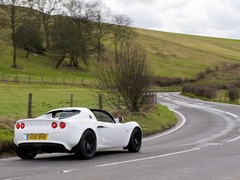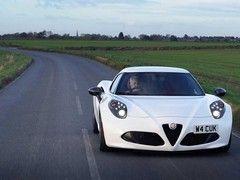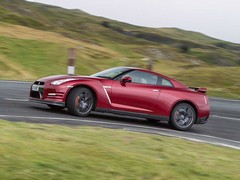Light cars are not the answer: Tell Me I'm Wrong
Powerfully built cars aren't necessarily evil argues our man - but is he right?

In fact, I'm almost happy when manufacturers sneak out the weight of a new car long after the launch excitement has died down for fear of it getting labelled a lard ass.
Don't get me wrong here: a Lotus Elise is a beautiful thing and I'll jump at the chance to drive anything that's been expertly pared to the bone for better track performance. But shaving kgs just to get the magic kerb weight figure down is usually a detriment to the drive experience, I find.
One company I like very much is Jaguar Land Rover. Oh it plays the lightness publicity game for all it's worth, for example bellowing about the weight saving achieved by the new aluminum body on the forthcoming Jaguar XE. But when the kg figure was finally revealed at 1,470kg for the lightest petrol-engined version, there was disappointment in these parts.
Wise investment
Thing is though, the engineers have banked the weight saved on the body and appear to have spent it wisely elsewhere. For example the rear suspension is a class-unique 'integral link' setup with a separate subframe, while the front suspension is double wishbone rather than struts. JLR's head of engineering Wolfgang Ziebart reckons the extra kilos are worth it. "Yes double wishbone is more complicated and it weighs slightly more, but you can do so much more in terms of controlling the vehicle," he told me back in October. This is a car I'm looking forward to driving.
Same goes for the Jaguar F-Type. The weight of the V6 Coupe is 1,577kg - no flyweight by any stretch. But the car feels so responsive through the steering wheel and eager to change direction you soon forget about weight. I asked the car's line director, Ian Hoban, about this and he argued persuasively that stiffness you get through targeted strengthening of the body structure (i.e. throwing more metal in there) is vital to achieving a precise steering response. "It's a balancing act between weight and stiffness," he said.
Of course where you place that weight is important - Jaguar for example puts the windscreen washer bottle in the rear to help get a 50/50 front/rear weight balance.
Out with the old
Myself and a mate discovered the benefits of strengthening a car about 10 years ago when we turned a perfectly decent £950 Ford Fiesta XR2 Mk2 into a Stock Hatch racer.
Stripping out the rear seats and tons of plastic trim didn't do much for the handling. Sticking a 30-40kg rollcage inside really did. With the extra stiffness of the rollcage and before we'd fitted the ride-destroying race dampers and shortened springs, the car was huge fun on the road.
Big weight with sophisticated suspension can be a glorious combination. Recently I drove a Bentley Continental GT V8 S, including on B-roads in the Peak District that had been laid with great sensitivity to the contours underneath. In other words there wasn't a flat bit on them. But this 2.3-tonne car just glided over the frequent camber changes - the compliant control it delivered was a sheer joy. I remember when the current Land Rover Discovery first came out back in 2004. The thing weighed 2.7 tonnes but the ride was sensational, beyond any SUV available at the time.
Because weight also adds refinement too. I know it's unfashionable to talk about this - I should be happy with ear defenders on, feeling the car squirming under me, steering wheel literally shaking with excitement with all the things it wants to tell me about the road surface. But I want to enjoy driving the car on all roads, not just the increasingly elusive empty, snaking ones.
Alpha male
The Alfa Romeo 4C is one car that has got this wrong, in my view. I've only driven it briefly but it was enough to tell me it's too hairshirt and weight obsessed for my tastes. Okay, so the carbon fibre tub is just 65kg and the carbon composite seats a puny 12kg, but the engine noise seemed too intrusive and the ride/handling too punishing. Fun for an afternoon definitely but not to own.
Even Lotus's new boss is making noises about making the Elise, Exige, Evora more refined, comfortable and easier to drive day-to-day. But this isn't all about adapting sports cars for commutes on the M40. Weight is also good for grip, as the man who created the Nissan GT-R, chief engineer Kazutoshi Mizuno told us back in 2009.
"The weight of a Formula 1 car is 600kg, but with 1,000kg of downforce in the high-speed bends," he said. "The GT-R is a normal sized car and cannot use 1,000kg downforce. So 1,750kg makes for a good tyre-grip load." His message was that light weight might be good for braking, but it's not so great for stability. While highly skilled professional drivers can deal with the sudden grip breakaways that bedevil lightweight cars, the rest of us can't so easily.
The younger me would be disgusted with this article. Light equals fun is a mantra that's hard to shake. But the older and more measured I become (okay, boring), the more I appreciate the control, refinement and predictability of heavier performance cars. Go on, tell me I'm wrong.
For me, I relish getting out of the CX7 and back into my MR2 because it 'feels' - the bumps, the scrabbly road bits, tugging on a tyre out of a bend etc etc. But at half past five on a dreary winter afternoon the CX7 offers a welcome haven against ill-tempered trucks and nutter reps.
But as a proposition for general motoring surely lightness and cheaper running costs are beneficial? Even though most mum's on the school run really love their 2.7 tonne pedestrian munchers.
I don't really see a close correlation with the enjoyment factor of the cars I have driven and how light they are.
I can appreciate the delicacy of feel a lightweight Lotus can bring, but I am equally mindful that when I last drove an Exige I couldn't get away from the sensation that I was stuck inside a lightweight biscuit tin.
Much of todays weight comes from safety systems - side impact bars, tct, airbags by the dozen, multi ECU's etc. The 4C is about right IMO. You could add add a little sound insulation for a very small weigh penalty to reduce engine noise if that really bothers you.
Heavy cars - better grip? Oh really? A Lotus Elan is still a benchmark for handling and grip, on 155 section tyres!
Added weight will help grip and ride in steady state maneuvers but makes changing speed or direction more difficult.
You mention that the Jaguars suspension is better for the additional heft, I'd counter that it is the easy choice to say that the suspension 'needs' to be heavy to work better; why not make it so that a double wishbone setup can be as light as a more simple setup with advancements in technology and engineering skill, thus offering the best of both worlds?
PH's words from the quoted interview:
"He will continue to improve the current cars, promising model enhancements to make them lighter"
I spend more time on the M3 than on track or country lanes hence I have a car weighing nearly 1.8 tons and I very much like it.
A light car car doesn't need beefy suspension, it doesn't need massive brakes and it doesn't need massive power to get the performance out of it (better economy).
Take the Veyron for example - massive power but massive weight so it's not particularly fast in corners and needs an airbrake to slow it down.
My GTM has a monocoque that's lighter than an Elise one, almost twice as stiff, as well as having comfortable and compliant suspension.
That was designed and built by a couple of guys in a shed.
I've not driven a 4C, but sitting in it highlighted a few things - appalling ergonomics. It's also got the wrong engine (although it's noise can easily be solved for minimal weight impact).
However, things like the XE could be much lighter, and would be better driver's cars if they were (not to say they aren't currently brilliant). The relationship of sprung to unsprung mass has an impact. The design and approach of that clever suspension could have been more innovative, but that would have cost more.
Grip is another thing. Increasing grip does not equal increasing enjoyment. The two are completely separate.
Conflating stiffness and grip with weight and enjoyment undermines your argument.
Reducing weight in a car is a virtuous circle with everything being able to become more delicate and precise. If the car is then set-up correctly then it can still have plenty of waft for the commute but not get all out of shape trying to wrangle it's lard around a corner when pushed hard. And then on top of all that you get improved fuel consumption and when you crash it's safer because there's less mass so less energy to be inflicted on the occupants.
Gassing Station | General Gassing | Top of Page | What's New | My Stuff











